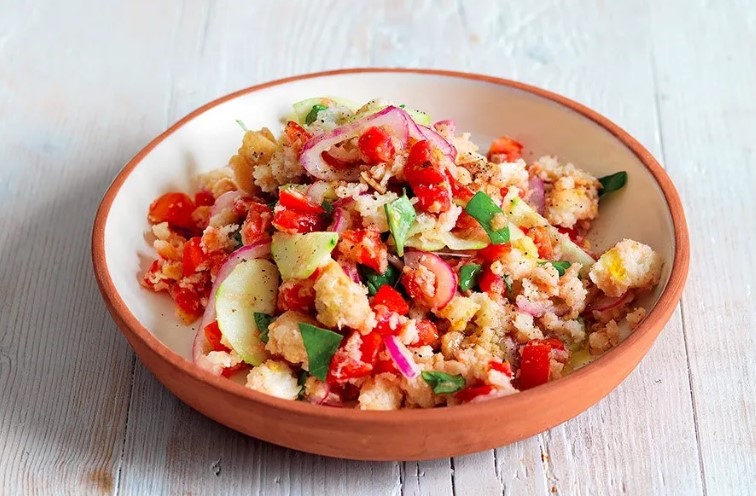SUMMER SCENTS, THE PANZANELLA
Ingredients:
Stale Tuscan bread (preferably unsalted), about 300 grams
4 ripe tomatoes
1 cucumber
1 red onion
1 bunch of fresh basil
Extra virgin olive oil
White wine vinegar
Salt
Pepper
Procedure:
Preparing the bread:
Cut the stale bread into slices and place them in a bowl with cold water for about 15-20 minutes until completely softened.
Squeeze the bread with your hands to remove excess water and crumble it coarsely into a large bowl.
Preparing the vegetables:
Wash and dice the tomatoes.
Peel the cucumber and cut it into thin slices.
Thinly slice the red onion.
Tear the fresh basil leaves by hand.
Assembly:
Add the tomatoes, cucumber, onion, and basil to the bowl with the bread.
Dress with plenty of extra virgin olive oil, a bit of white wine vinegar, salt, and pepper to taste.
Mix all the ingredients well so the bread absorbs the flavors of the vegetables and seasonings.
Resting:
Let the panzanella rest in the refrigerator for at least 1 hour before serving, allowing all the flavors to blend well.
Origins of Panzanella
Panzanella is a typical dish of Tuscan cuisine, originating from peasant tradition. Its origins date back to the Middle Ages, when Tuscan peasants used stale bread to create simple yet nutritious dishes, utilizing ingredients available from their gardens.
The name "panzanella" likely derives from the combination of the words "pane" (bread) and "zanella" (which in Tuscan dialect means "bowl" or "dish"). This dish was traditionally prepared with soaked stale bread, onion, and other fresh garden ingredients such as tomatoes and cucumbers.
Characteristics of Panzanella
Economical and sustainable: Panzanella is a classic example of "cucina di recupero" (recovery cuisine), as it uses stale bread that would otherwise be discarded.
Fresh and light: It is a summer dish, fresh and light, ideal for hot days.
Simplicity: Panzanella is characterized by the simplicity of its ingredients and ease of preparation.
Versatility: Although the traditional Tuscan recipe is the most well-known, there are numerous regional and personal variations that include other ingredients like olives, capers, tuna, and bell peppers.
Nutritious: Thanks to the presence of fresh vegetables and olive oil, panzanella is rich in vitamins, minerals, and healthy fats.
Panzanella not only represents a dish of the Tuscan gastronomic tradition but also exemplifies how cuisine can be healthy, sustainable, and delicious using simple and genuine ingredients.
Photo: Lacucinaitaliana.it


 English
English Italiano
Italiano Deutsch
Deutsch Français
Français